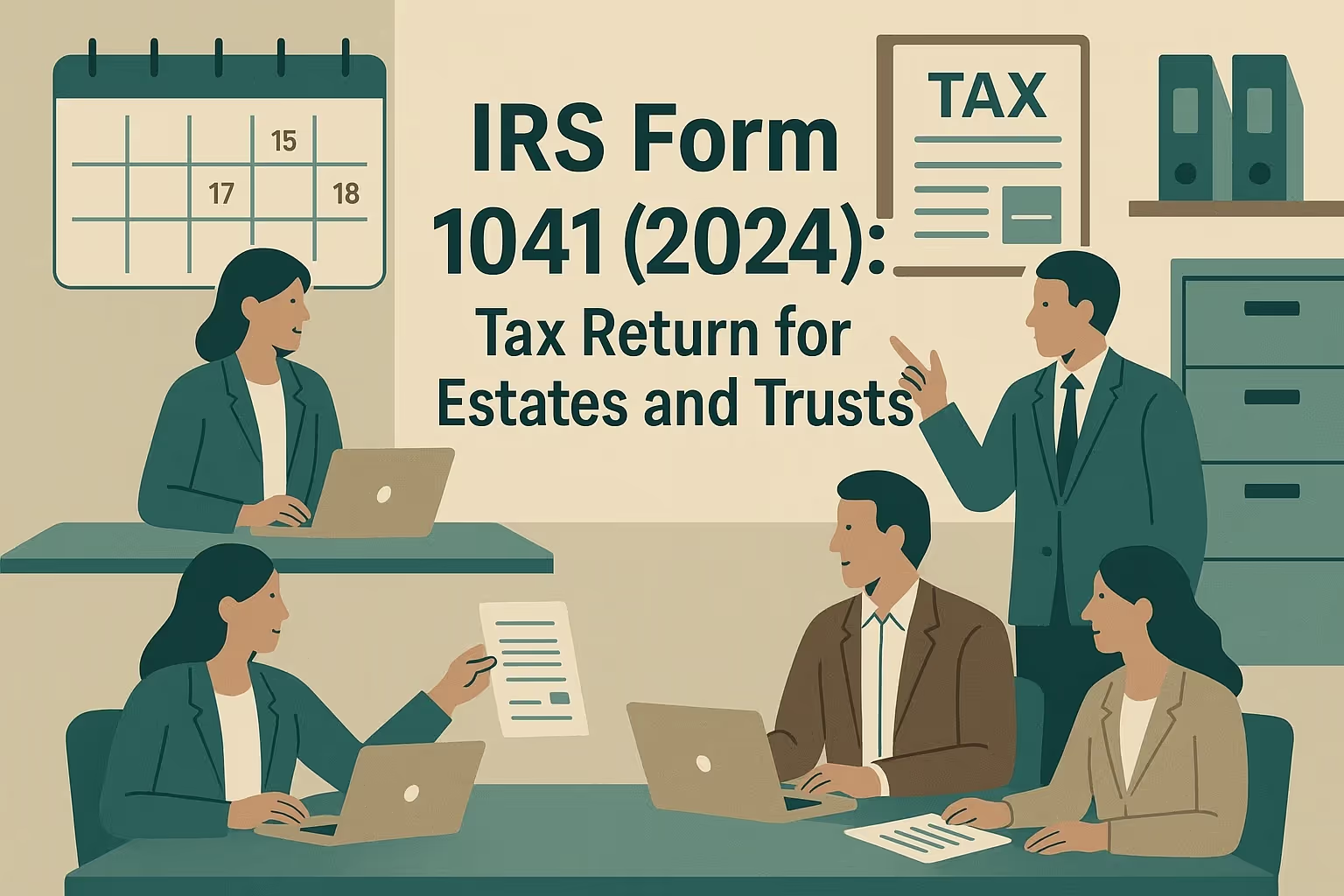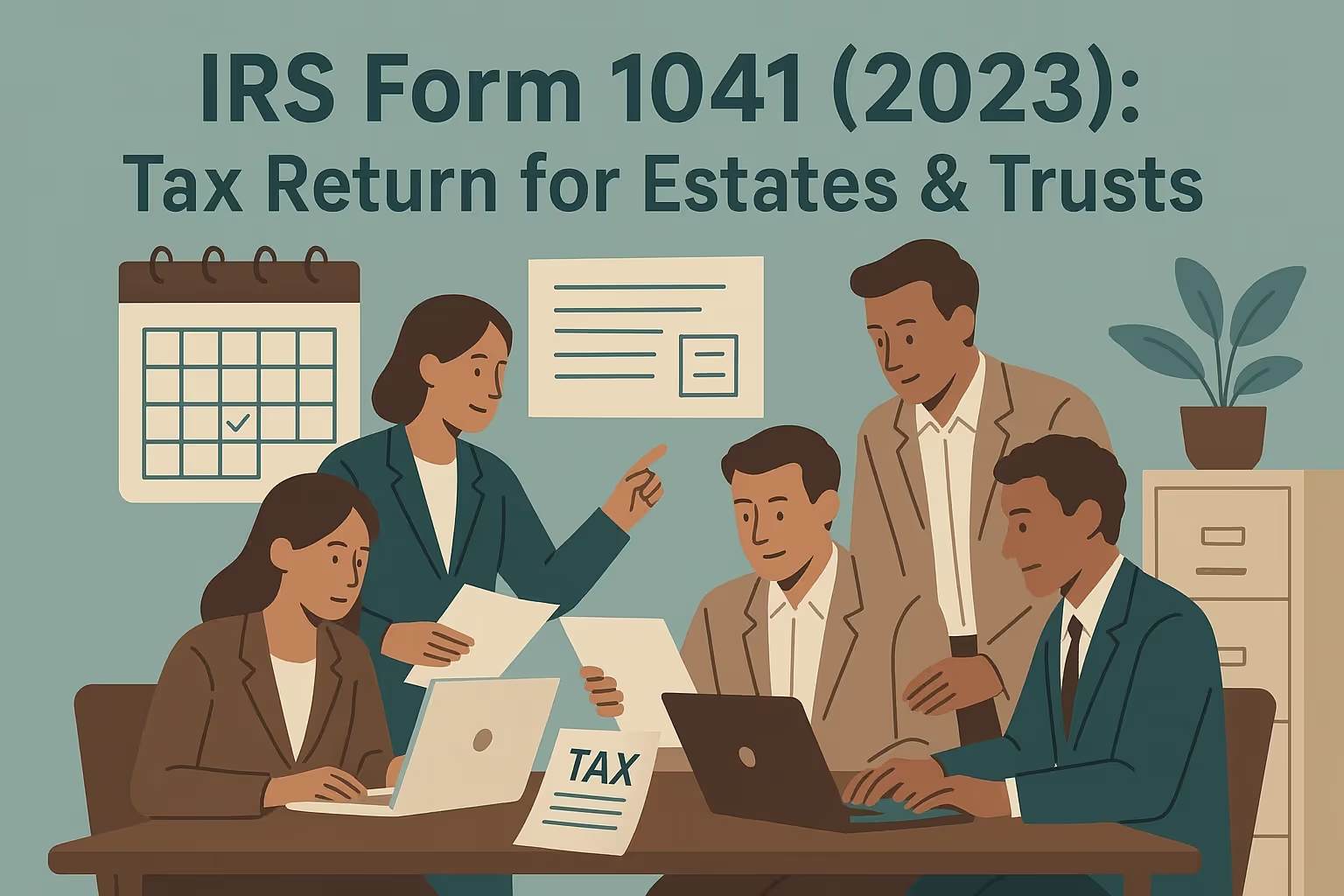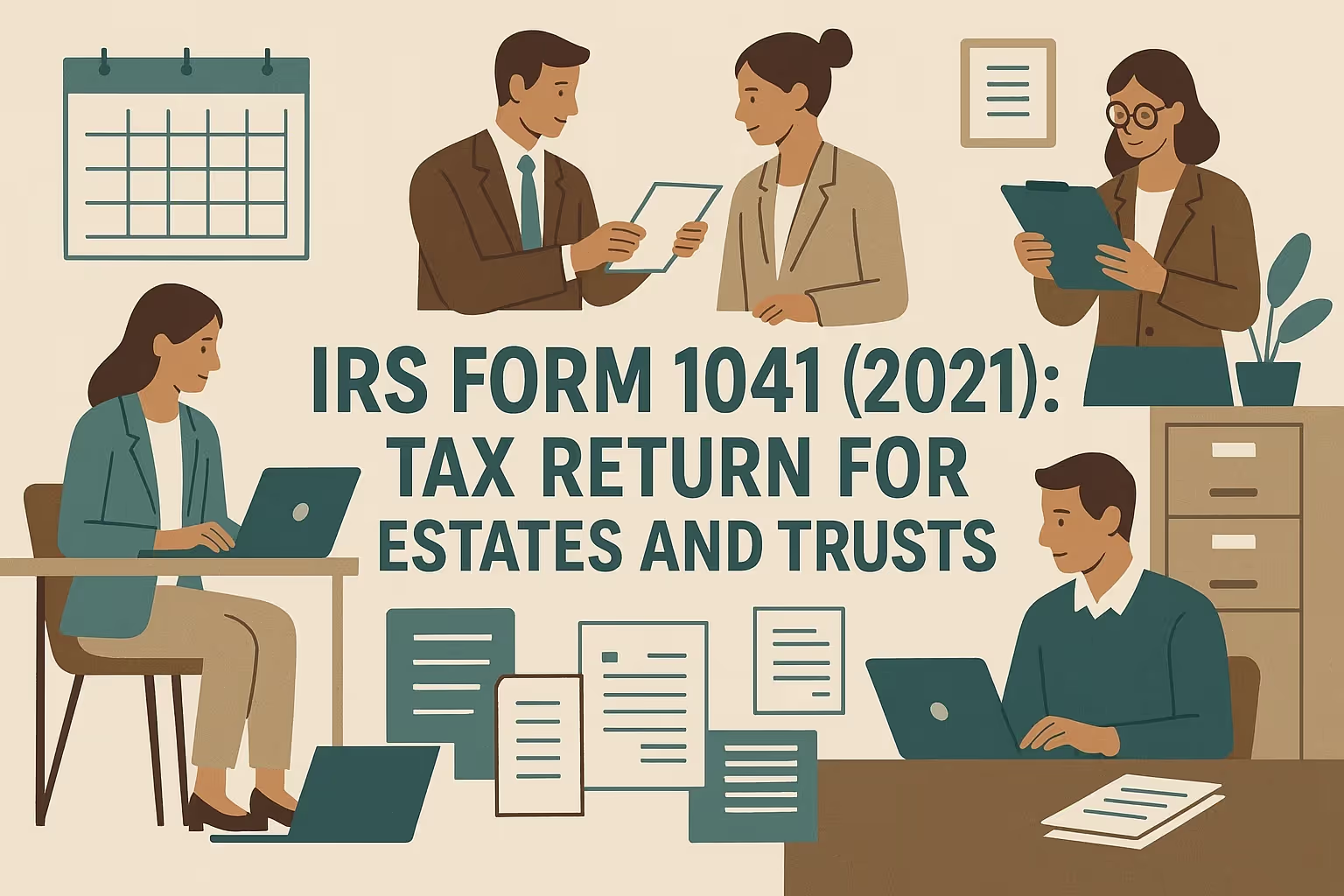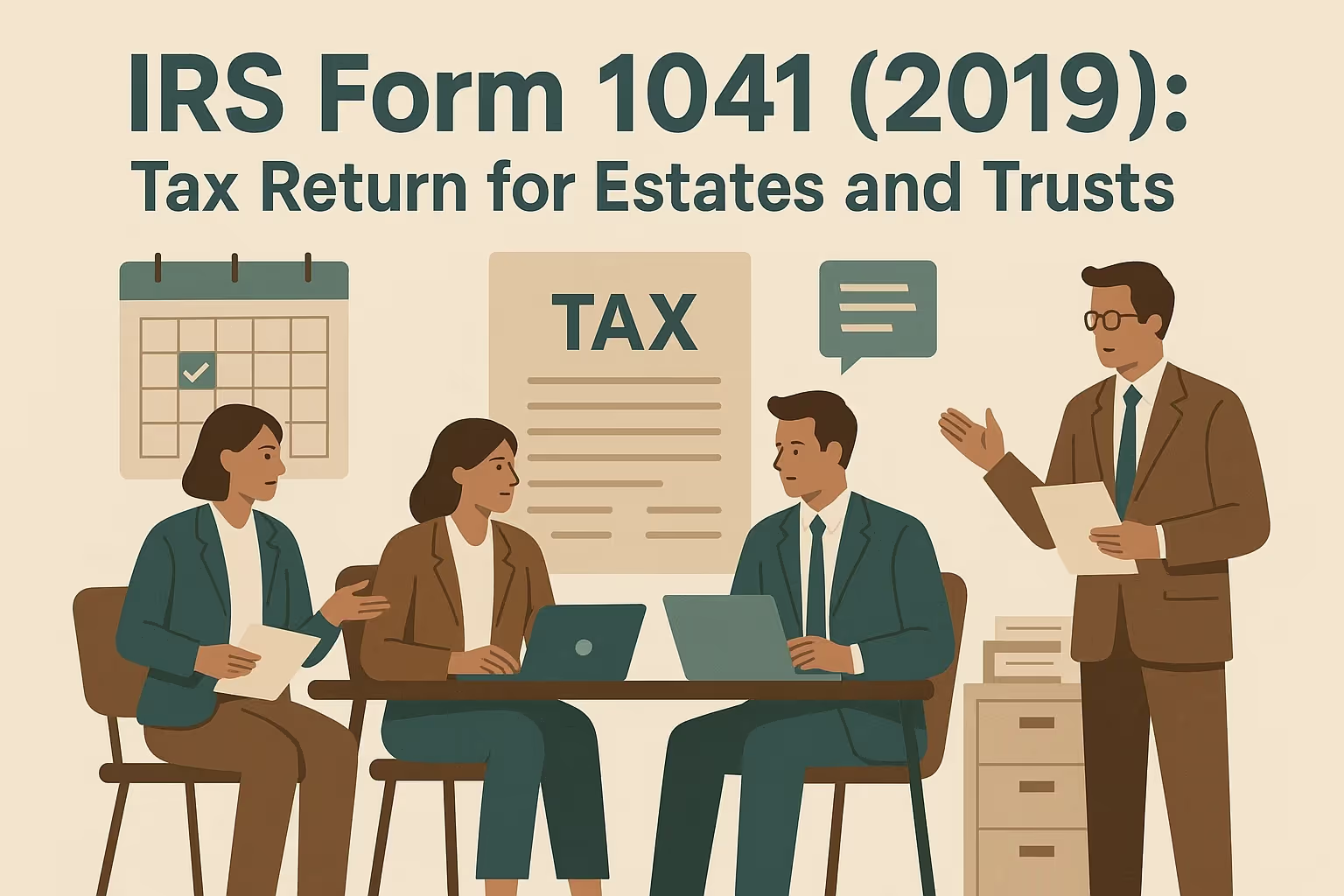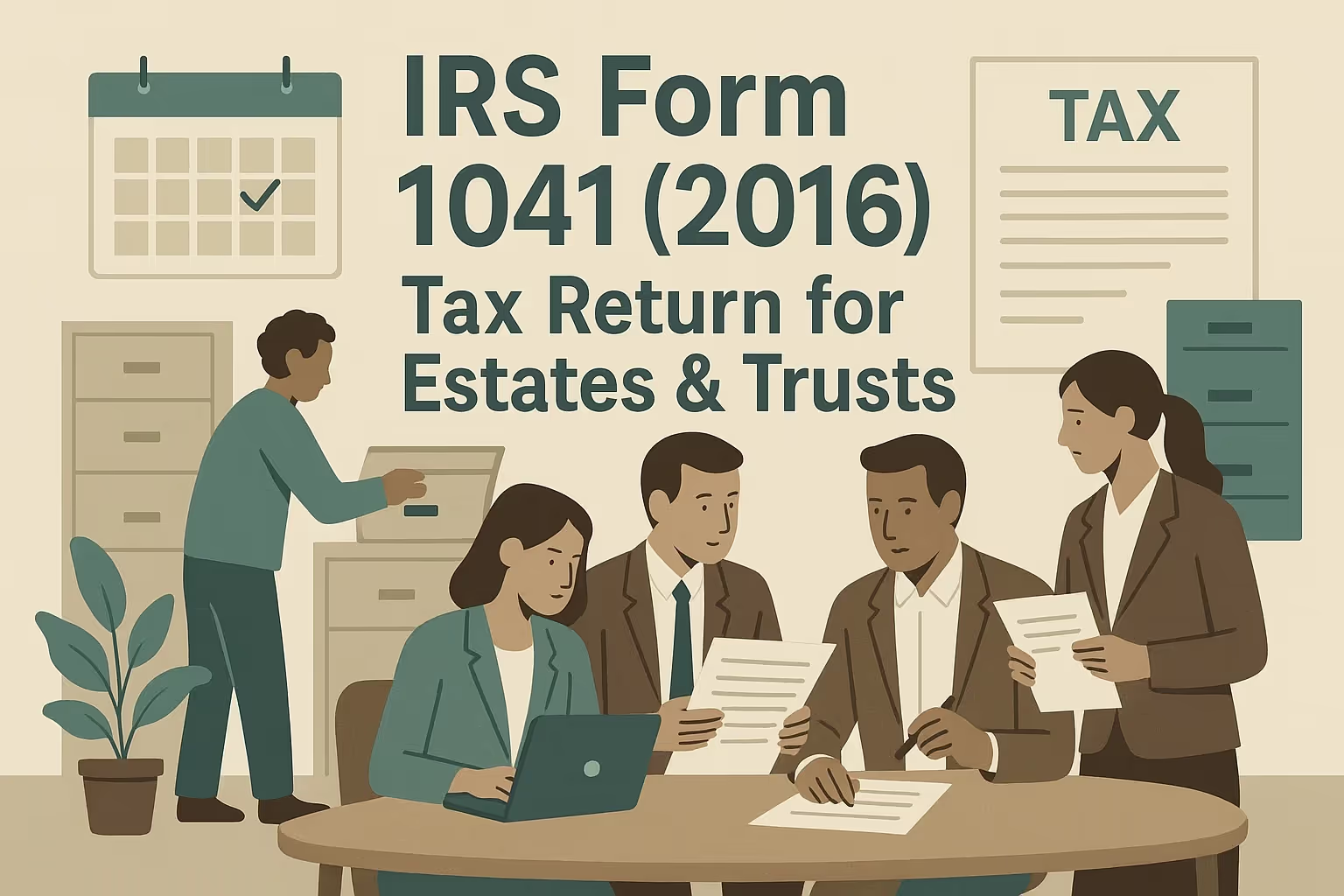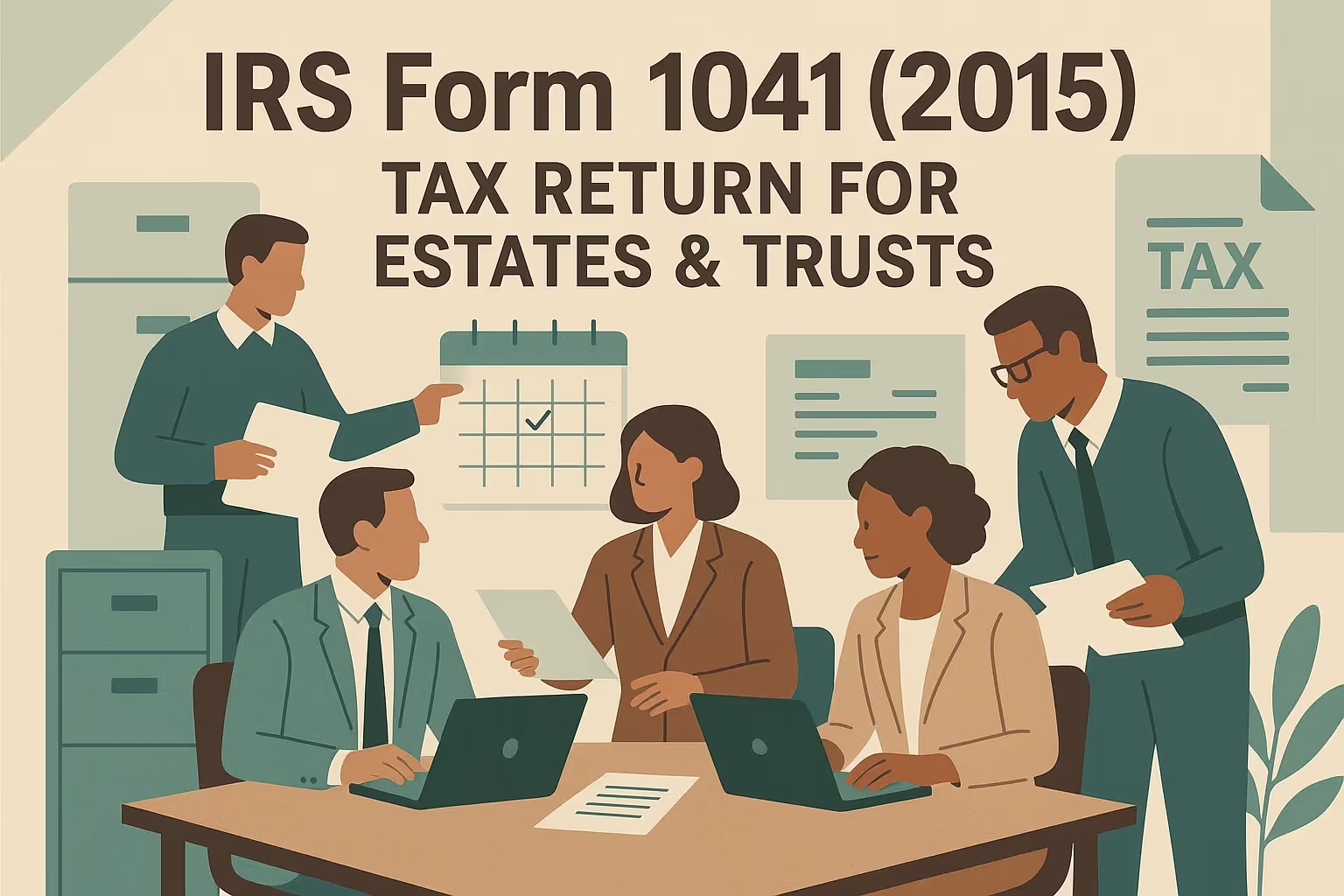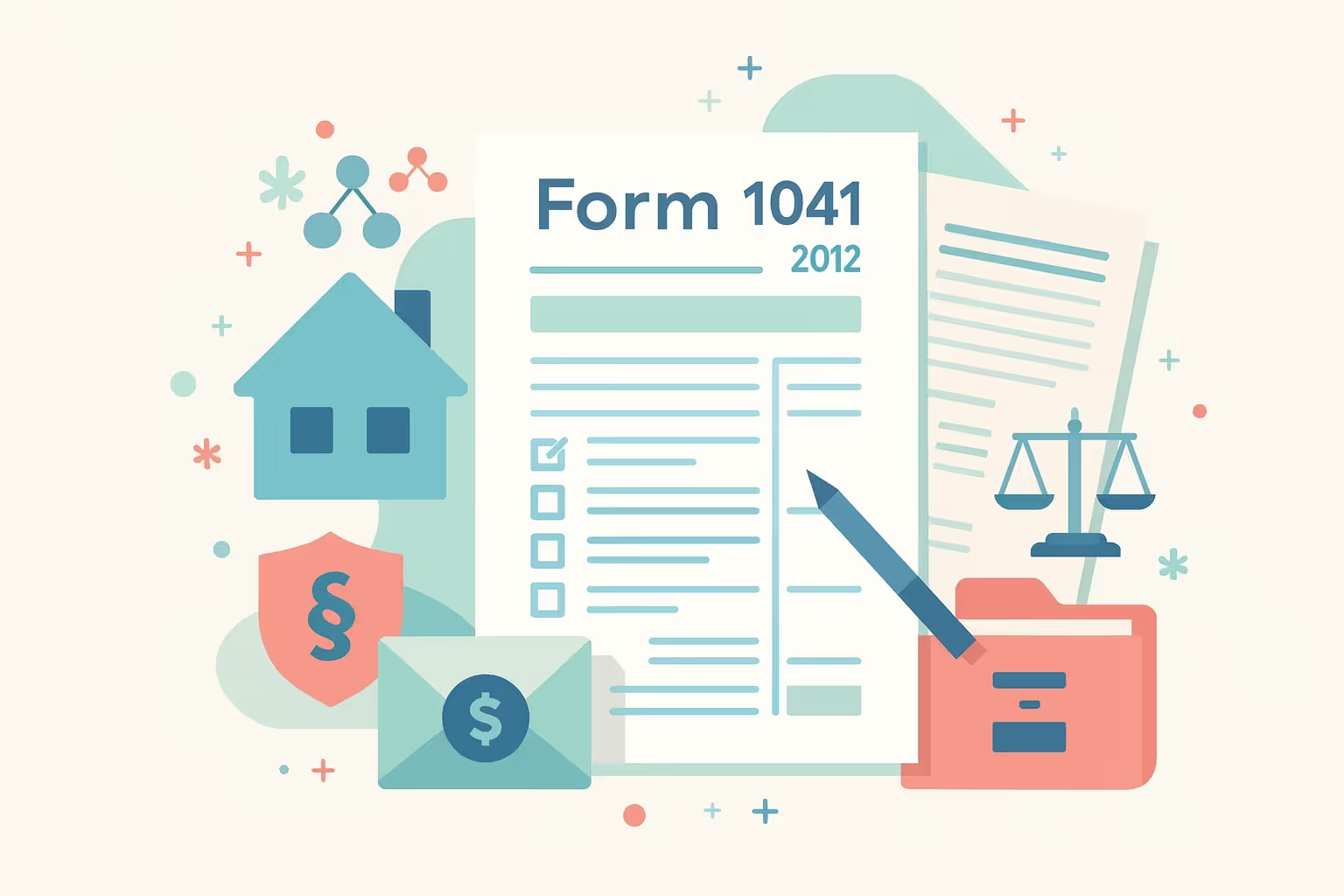Instrucciones del formulario 1041 2013: presentación de impuestos federales sobre el patrimonio

La presentación de una declaración fiduciaria de impuestos sobre la renta de un patrimonio o fideicomiso requiere una comprensión clara de las responsabilidades que surgen al fallecer una persona. El representante personal o el fideicomisario deben declarar los ingresos generados por propiedades, inversiones y otros activos generadores de ingresos mantenidos después de la fecha del fallecimiento. Esta información se presenta mediante el formulario 1041, la declaración oficial de impuestos sobre el patrimonio reconocida en virtud del Código de Impuestos Internos. A diferencia de una declaración de impuestos sobre la renta personal, este formulario cubre los ingresos generados por los activos fiduciarios, las distribuciones a los beneficiarios y las deducciones relacionadas con la administración y administración del patrimonio.
Para el año tributario 2013, la presentación era obligatoria cuando un patrimonio generaba al menos 600 dólares en ingresos brutos anuales o incluía a un beneficiario extranjero no residente. Las sucesiones y los fideicomisos pueden contener una variedad de propiedades generadoras de ingresos, donaciones vitalicias o inversiones heredadas que siguen generando ingresos después de la liquidación patrimonial del difunto. La declaración de todos los ingresos garantiza un cálculo preciso de los créditos, exenciones y pasivos tributarios, lo que permite a los fiduciarios cumplir con sus obligaciones con precisión.
El Servicio de Impuestos Internos exige el formulario 1041 para declarar los ingresos, las deducciones y los activos distribuidos. El funcionario de la agencia Descripción general del formulario 1041 proporciona información detallada sobre los requisitos de presentación, las normas de declaración de ingresos y los plazos aplicables para ayudar a los fiduciarios a cumplir con las normas.
Quién debe presentar y cuándo presentar el formulario 1041
La presentación del formulario 1041 es una responsabilidad legal para cada representante personal, fideicomisario o albacea que administre un patrimonio o fideicomiso que genere ingresos imponibles. El formulario informa sobre los ingresos generados después de la fecha del fallecimiento, las deducciones reclamadas en virtud del Código de Impuestos Internos y los activos distribuidos a los beneficiarios. Comprender estos umbrales de presentación ayuda a los fiduciarios a cumplir con los estándares federales de cumplimiento y a evitar complicaciones innecesarias. Cada patrimonio o fideicomiso se trata como una entidad tributaria independiente, distinta de la declaración de impuestos sobre la renta personal del difunto.
Un patrimonio o fideicomiso debe declararse cuando su ingreso bruto anual sea igual o superior a 600 dólares durante el año tributario. La presentación también es obligatoria cuando un beneficiario es un extranjero no residente, independientemente de su nivel de ingresos. El Servicio de Impuestos Internos clasifica las sucesiones y los fideicomisos en categorías específicas, cada una con sus propios requisitos de presentación y tratamiento tributario. La clasificación adecuada garantiza la presentación precisa de informes sobre los ingresos generados por los activos fiduciarios, las propiedades generadoras de ingresos y las cuentas de inversión.
- Patrimonio del difunto: Este tipo de patrimonio se crea al fallecer para administrar todos los activos y liquidar las obligaciones. El patrimonio debe declarar cualquier ingreso obtenido antes de la distribución.
- Confianza simple: Se requiere un fideicomiso simple para distribuir todos los ingresos del fideicomiso anualmente a los beneficiarios y no puede hacer contribuciones caritativas.
- Confianza compleja: Un fideicomiso complejo puede acumular ingresos, distribuir fondos o hacer contribuciones caritativas. Estas entidades suelen generar ingresos a partir de participaciones diversificadas.
- Fideicomiso cedente: Se considera que un fideicomiso es propiedad del otorgante, lo que significa que la persona declara todos los ingresos obtenidos directamente en su declaración de impuestos sobre la renta personal.
- Confianza irrevocable: Un fideicomiso irrevocable se reconoce como un contribuyente independiente responsable de pagar su propia obligación tributaria sobre la renta.
- Fideicomiso extranjero: Un fideicomiso extranjero está sujeto a requisitos especiales de presentación de informes para los ingresos procedentes de los Estados Unidos.
El representante personal debe asegurarse de que el patrimonio o fideicomiso obtenga un número de identificación patronal (EIN) antes de presentar la solicitud con su propio nombre. Los sucesores pueden elegir un año fiscal que termine el último día de cualquier mes, o seguir un año calendario que finalice el 31 de diciembre. Los fideicomisos suelen presentarse según el año calendario. La fecha de vencimiento de la mayoría de las sucesiones y fideicomisos del año calendario es el día 15 del cuarto mes siguiente al cierre del año tributario.
Comprender quién debe presentar la solicitud y cuándo garantiza que cada fiduciario cumpla con las obligaciones de presentación necesarias. La presentación oportuna preserva el cumplimiento, protege los intereses de los beneficiarios y establece un registro completo ante el Servicio de Impuestos Internos.
Actualizaciones de la ley tributaria de 2013 y cambios en la exención del impuesto sobre sucesiones
Las actualizaciones clave del año tributario 2013 cambiaron la forma en que los fiduciarios administraban las declaraciones de impuestos sobre el patrimonio y los informes relacionados con los fideicomisos. Los ajustes al Código de Impuestos Internos aumentaron las categorías impositivas más altas, ampliaron los umbrales de exención del impuesto sobre sucesiones e introdujeron nuevos requisitos para los ingresos por inversiones.
Estos cambios afectaron la forma en que los fiduciarios calculaban la obligación tributaria, administraban los ingresos generados por los activos y coordinaban las distribuciones a los beneficiarios. La revisión de estas actualizaciones garantiza el cumplimiento de las obligaciones tributarias federales y la presentación de informes precisos ante el Servicio de Impuestos Internos.
Aumento de la tasa máxima del impuesto sobre la renta
- Las sucesiones y los fideicomisos alcanzaron la tasa máxima del impuesto sobre la renta, del 39,6 por ciento, una vez que los ingresos imponibles superaron los 11.950 dólares en 2013.
- Este cambio enfatizó la importancia de asignar los ingresos adecuadamente entre el patrimonio y los beneficiarios para garantizar una tributación justa.
- Los fiduciarios que administran activos generadores de ingresos deben supervisar de cerca los montos imponibles para minimizar la exposición a tramos impositivos más altos.
Ajustes de la tasa de ganancias de capital
- La tasa máxima de ganancias de capital a largo plazo aumentó al 20 por ciento para las sucesiones y fideicomisos de ingresos más altos.
- Las ganancias por ventas de propiedades, inversiones o transacciones inmobiliarias contribuyeron directamente al ingreso total obtenido durante el año tributario.
- La categorización adecuada de las ganancias de capital en la declaración del impuesto sobre el patrimonio garantizó el cumplimiento constante de las disposiciones del Código de Impuestos Internos.
Introducción del impuesto sobre la renta neta de inversiones (NIIT)
- El impuesto sobre la renta neta de inversiones del 3.8 por ciento se aplica a los ingresos por inversiones no distribuidos obtenidos en sucesiones y fideicomisos.
- Los fiduciarios deben presentar el formulario 8960 junto con el formulario 1041 al declarar esta obligación tributaria específica.
- Los fiduciarios calculan los ingresos generados por intereses, dividendos y otras fuentes pasivas sujetas a este impuesto.
- El IRS brinda orientación detallada a través de su Formulario 8960: Impuesto sobre la renta neta de inversiones página, que explica las reglas de cálculo y los requisitos de presentación.
Exención del impuesto sobre el patrimonio para 2013
- La exención del impuesto sobre el patrimonio aumentó a 5,25 millones de dólares por difunto, lo que cubre todos los activos transferidos al fallecer.
- Las propiedades que superaban este umbral estaban obligadas a pagar impuestos sobre los montos que superaran el límite de exención.
- La documentación adecuada garantizó una valoración precisa de la propiedad, las donaciones de por vida y los activos heredados al completar la declaración de impuestos sobre el patrimonio.
Actualizaciones de presentación y firma electrónicas
- Los fiduciarios obtuvieron acceso a la presentación electrónica en 2013 mediante el formulario 8453-FE o el formulario 8879-F para firmas electrónicas.
- La presentación electrónica mejoró la precisión, proporcionó un procesamiento más rápido y redujo los errores de envío manual.
- Las sucesiones y fideicomisos que administran propiedades complejas se beneficiaron de la confirmación oportuna de las solicitudes aceptadas.
El cumplimiento continuo de las regulaciones de 2013 requiere una documentación cuidadosa, un cálculo preciso y una comprensión de cada exención y tasa aplicada. Estos ajustes siguen influyendo en la forma en que los fiduciarios planifican las declaraciones, valoran los ingresos de los fideicomisos y cumplen con las obligaciones en virtud del Servicio de Impuestos Internos.
Guía paso a paso para completar la declaración de impuestos sobre la renta fiduciaria
La preparación de una declaración fiduciaria de impuestos sobre la renta requiere una organización metódica y atención a cada detalle de los informes. Cada paso garantiza que los ingresos obtenidos, las deducciones reclamadas y los activos distribuidos se informen con precisión según el Código de Impuestos Internos.
El proceso implica recopilar los documentos esenciales, clasificar los ingresos generados durante el año tributario, aplicar las deducciones y completar los cronogramas necesarios. Seguir estos pasos ayuda a los fiduciarios a mantener el cumplimiento y a determinar con precisión la obligación tributaria sobre la renta por sucesiones y fideicomisos.
Paso 1. Reúna los registros esenciales
Comience por recopilar todos los registros requeridos antes de ingresar cualquier dato. Recopile documentos como el testamento o el instrumento fiduciario, la información del beneficiario, el número de identificación del empleador y los estados financieros que muestren todos los activos que generan ingresos. Incluya los documentos de respaldo de los ingresos, como los formularios 1099, K-1 u otras declaraciones de impuestos. Al organizar estos elementos primero, se asegura de que todas las entradas de la declaración de impuestos sobre el patrimonio reflejen información completa y verificada.
Paso 2. Información completa de la entidad
Proporcione una identificación precisa en la parte superior del formulario 1041, que incluya el nombre legal del patrimonio o fideicomiso, el número de identificación del empleador y la dirección actual. Indique si la persona que presenta la declaración es el patrimonio, el fideicomiso del cedente, el fideicomiso simple, el fideicomiso complejo u otra clasificación del difunto. Especifique el período de presentación, ya sea por año calendario o por año fiscal. Proporcione el nombre y cargo del representante fiduciario o personal responsable de firmar la declaración.
Paso 3. Reporte todos los ingresos obtenidos
Revele todas las fuentes de ingresos generadas durante el año. Las categorías comunes incluyen los intereses, los dividendos, los ingresos comerciales, las ganancias de capital, los ingresos por alquileres y los ingresos relacionados con el difunto. Si el patrimonio o el fideicomiso incluyen inversiones extranjeras o ingresos de sociedades colectivas, anote también estos montos. La categorización adecuada distingue los ingresos imponibles de los artículos exentos, lo que garantiza que cada entrada cumpla con los requisitos del Servicio de Impuestos Internos.
Paso 4. Reclame las deducciones permitidas
Enumere todas las deducciones permitidas por el Código de Impuestos Internos. Por lo general, incluyen los honorarios fiduciarios, los gastos administrativos, los honorarios de abogados o contadores, las contribuciones caritativas y los impuestos estatales o locales. Asegúrese de que cada deducción esté directamente relacionada con la administración o la preservación de bienes o activos fiduciarios. La documentación precisa respalda cada deducción solicitada y evita declaraciones erróneas en los ingresos imponibles.
Paso 5. Complete los cronogramas requeridos
Adjunte los cronogramas que respalden la asignación de ingresos, el cálculo de impuestos y los informes de los beneficiarios. Utilice el Anexo B para calcular la deducción por distribución de ingresos y el Anexo G para determinar la obligación tributaria total. Si las distribuciones abarcan varios años o incluyen distribuciones acumuladas, complete el Anexo J. Incluya el formulario 8960 cuando declare los ingresos por inversiones no distribuidos sujetos al impuesto sobre la renta neta de inversiones.
Paso 6. Calcule el total de impuestos y pagos
Después de anotar todos los ingresos y deducciones, calcule el impuesto total adeudado por el patrimonio o fideicomiso. Reste los créditos tributarios o los pagos estimados realizados anteriormente. Incluya los pagos a través del Sistema Electrónico de Pago de Impuestos Federales o con un comprobante de pago al presentar la declaración. Verifique que el total de los pagos y créditos compense el saldo restante adeudado.
Paso 7. Revise y presente la declaración
Realice una revisión exhaustiva antes de la presentación. Revise la declaración para comprobar su precisión numérica, verifique que todos los cronogramas estén adjuntos y asegúrese de que cada sección refleje datos consistentes. Firme y feche la declaración, luego preséntela electrónicamente o envíela por correo a la dirección correcta del IRS. Guarde copias de todos los documentos presentados para consultarlos en el futuro.
La preparación precisa fortalece el mantenimiento de registros, protege a los beneficiarios y reduce la probabilidad de demoras en la presentación o correcciones. Una declaración fiduciaria de impuestos sobre la renta bien documentada también respalda la transparencia en la administración del patrimonio y genera confianza entre todas las partes involucradas. El mantenimiento de registros detallados durante todo el proceso garantiza que las futuras presentaciones y liquidaciones patrimoniales se realicen de manera eficiente.
Informar sobre la participación y los activos distribuidos del beneficiario
Los fiduciarios deben declarar con precisión la participación de cada beneficiario en los ingresos del patrimonio o fideicomiso para garantizar una tributación adecuada. El anexo K-1 sirve como documento de presentación de informes que detalla los ingresos generados, las deducciones aplicadas y los créditos asignados a cada beneficiario. La declaración fiduciaria del impuesto sobre la renta refleja cómo se distribuyen los ingresos obtenidos de los activos o propiedades del fideicomiso, ya sea que la entidad los retenga o los transfiera a los beneficiarios. La presentación de informes transparentes evita la duplicación de impuestos y garantiza que cada parte cumpla con el Código de Impuestos Internos.
Los beneficiarios se basan en esta información para completar su declaración de impuestos sobre la renta personal, por lo que cada entrada debe coincidir con las cifras informadas en el formulario 1041. Los ingresos distribuidos a través de un patrimonio o fideicomiso pueden incluir intereses, dividendos, ganancias de capital y otras categorías imponibles. La participación de cada beneficiario debe corresponder a los términos del documento rector, que especifica cómo se dividen los activos distribuidos entre los destinatarios. Una revisión cuidadosa de los registros de distribución garantiza el cumplimiento y la precisión en todos los documentos de presentación de informes.
- Ingresos ordinarios: Incluya los salarios, los ingresos comerciales, los intereses y los dividendos generados por los activos que generan ingresos.
- Ganancias de capital: Reporte cualquier beneficio de la venta de propiedades u otras inversiones.
- Intereses exentos de impuestos: Identifique los ingresos que permanecen exentos de impuestos federales pero que aún deben figurar en el Anexo K-1.
- Créditos y deducciones: Refleja los ajustes que pueden reducir el ingreso imponible total o calificar para créditos tributarios específicos.
- Ingresos extranjeros: Incluya cualquier ganancia de un fideicomiso extranjero o de inversiones de origen extranjero.
- Distribuciones de bienes: Registre las transferencias de propiedad y los montos del patrimonio del difunto que se consideran ingresos según el Código de Impuestos Internos.
- Asignaciones caritativas: Documente los ingresos destinados a organizaciones caritativas si lo autoriza el instrumento fiduciario.
Cuando todos los detalles del informe coinciden entre la declaración fiduciaria y la copia del beneficiario, ambas partes mantienen la coherencia y reducen el riesgo de discrepancias durante la revisión del IRS. Cada fiduciario debe verificar que las asignaciones acumuladas no superen los ingresos totales declarados para el patrimonio o el fideicomiso. Las discrepancias en la valoración de los activos o en la clasificación de los ingresos pueden provocar ajustes, lo que a su vez puede retrasar tanto el procesamiento como la liquidación final.
La documentación precisa de los ingresos y los activos distribuidos demuestra la transparencia y la responsabilidad en la administración del patrimonio. Garantizar que las acciones de cada beneficiario se registren correctamente contribuye a la equidad, el cumplimiento y la confianza durante todo el proceso de presentación. Este enfoque promueve una tributación precisa para todos los beneficiarios y refuerza el deber de diligencia del fiduciario.
Número de identificación del empleador y opciones de presentación
Cada patrimonio o fideicomiso debe obtener un número de identificación del empleador para garantizar la presentación precisa de su declaración fiduciaria de impuestos sobre la renta. El EIN distingue los registros financieros de la entidad de la declaración de impuestos sobre la renta personal del difunto y permite una identificación adecuada dentro del sistema del Servicio de Impuestos Internos. Sin un EIN válido, un patrimonio o fideicomiso no puede declarar ingresos, solicitar deducciones ni distribuir activos generadores de ingresos de conformidad con la ley federal.
- Qué es un número de identificación del empleador: Un EIN es un número de nueve dígitos asignado a empresas y otras entidades con fines de declaración de impuestos según el Código de Rentas Internas. Identifica a la entidad como un contribuyente distinto, al igual que un número de seguro social identifica a una persona. Cada patrimonio o fideicomiso debe obtener un EIN antes de completar el formulario 1041.
- Por qué se requiere un EIN: El EIN permite informar con precisión de los ingresos generados por la propiedad y otros activos patrimoniales. Separa las actividades financieras fiduciarias de las declaraciones anteriores del difunto y permite al fiduciario o al fideicomisario administrar las cuentas, las inversiones y los pagos en nombre del patrimonio o fideicomiso.
- Cuándo solicitar un EIN: Presente la solicitud inmediatamente después de la muerte del difunto, una vez que se haya formado el patrimonio o el fideicomiso entre en vigor. La solicitud temprana garantiza la presentación oportuna de informes, el seguimiento preciso de los ingresos y la presentación de las declaraciones de impuestos sobre el patrimonio.
- Cómo solicitar un EIN: Presente su solicitud en línea a través del sitio web del IRS, envíe por correo el formulario SS-4 o solicite por teléfono si se encuentra fuera de los Estados Unidos. El registro en línea proporciona una confirmación inmediata, lo que permite a los fiduciarios comenzar a administrar los activos a nombre de la entidad.
- Elección de un método de presentación: Seleccione entre la presentación electrónica y la presentación en papel para la declaración fiduciaria de impuestos sobre la renta. La presentación electrónica ofrece un procesamiento más rápido y una validación automatizada, mientras que la presentación en papel es adecuada para declaraciones complejas con varios archivos adjuntos.
- Selección del período de presentación: Las sucesiones pueden usar un año fiscal que termina el último día de cualquier mes, mientras que los fideicomisos generalmente se archivan en un año calendario que termina el 31 de diciembre. El período de presentación determina los plazos para presentar el formulario 1041 y los pagos de impuestos estimados.
Obtener un EIN y seleccionar un método de presentación adecuado son pasos esenciales para el cumplimiento. Estas medidas respaldan la transparencia de la presentación de informes, mantienen registros ordenados y ayudan a los fiduciarios a cumplir con sus obligaciones en virtud de la ley tributaria federal. El establecimiento de estos elementos fundamentales en las primeras etapas del proceso también minimiza las demoras administrativas durante el proceso de presentación y distribución de ingresos. El cumplimiento cuidadoso de estos requisitos refuerza la precisión de las declaraciones futuras y genera credibilidad ante los beneficiarios y las autoridades tributarias.
Consideraciones sobre pagos, prórrogas e impuestos sobre donaciones
Cumplir con todas las obligaciones de pago y presentación es una responsabilidad fundamental de los fiduciarios que administran sucesiones y fideicomisos. Cada declaración fiduciaria de impuestos sobre la renta debe reflejar los pagos puntuales y la presentación de informes precisos según el Código de Impuestos Internos.
Comprender los métodos de pago disponibles, los procedimientos de extensión y la coordinación del impuesto sobre donaciones garantiza el cumplimiento y evita problemas administrativos o de intereses innecesarios. Prestar especial atención a los plazos de pago contribuye a una gestión adecuada de los ingresos obtenidos, los activos fiduciarios y las distribuciones a los beneficiarios.
Realización de pagos
El fiduciario debe pagar el saldo total de la obligación tributaria sobre la renta antes de la fecha de vencimiento original, incluso si presenta una prórroga. Los pagos se pueden realizar electrónicamente a través del Sistema electrónico de pago de impuestos federales, una plataforma segura que proporciona confirmación inmediata y programación de pagos.
Los patrimonios y fideicomisos también pueden pagar con un cheque o giro postal con el formulario 1041-V, o con una tarjeta de crédito o débito a través de un procesador aprobado. Los pagos electrónicos reducen las demoras y garantizan un crédito puntual para el año tributario correspondiente. Los fiduciarios deben documentar todas las transacciones y conservar las confirmaciones para garantizar que los registros sean precisos.
Solicitud de una prórroga
Una extensión brinda tiempo adicional para presentar el formulario 1041, pero no extiende la fecha límite de pago. Los fiduciarios pueden usar el formulario 7004 para solicitar una prórroga de cinco meses para la presentación automática. La fecha límite extendida se aplica solo a la presentación de la declaración, no al impuesto adeudado. Para cumplir con las normas, los fiduciarios deben estimar el total de los impuestos adeudados y remitir el pago antes de la fecha de vencimiento original para evitar la acumulación de intereses. Conservar copias de la solicitud de prórroga y de las confirmaciones de pago demuestra diligencia a la hora de cumplir con los requisitos federales de presentación.
Coordinación de las obligaciones tributarias sobre donaciones y sucesiones
El Código de Impuestos Internos exige la coordinación entre las declaraciones de impuestos sobre el patrimonio y cualquier obligación tributaria sobre donaciones que surja de las donaciones de por vida hechas por el difunto. Los fiduciarios deben revisar las transferencias anteriores para determinar si es necesaria una presentación separada del impuesto sobre donaciones. Las donaciones vitalicias que superaron los límites de exclusión anuales deben declararse para garantizar un cálculo preciso tanto de la exención del impuesto sobre el patrimonio como del valor total del patrimonio. Consultar a un abogado especializado en planificación patrimonial ayuda a verificar las declaraciones anteriores y garantiza la documentación adecuada para las donaciones, transferencias y contribuciones fiduciarias. Los informes exhaustivos refuerzan el cumplimiento y reducen la exposición a futuras disputas o evaluaciones.
El cumplimiento de los plazos de pago, la solicitud precisa de prórrogas y la consideración del impuesto sobre donaciones reflejan el compromiso del fiduciario con la administración responsable. La gestión de estos elementos protege eficazmente los activos patrimoniales y fiduciarios, evita responsabilidades inesperadas y garantiza el cumplimiento de las normas del Servicio de Impuestos Internos. La coordinación adecuada entre los informes de impuestos sobre la renta y el patrimonio establece un registro financiero claro que beneficia tanto a los fiduciarios como a los beneficiarios.
Errores de presentación comunes en sucesiones y fideicomisos
La presentación de declaraciones fiduciarias de impuestos sobre la renta requiere precisión, atención a los detalles y una comprensión clara del Código de Impuestos Internos. Los errores suelen ocurrir cuando los fiduciarios clasifican erróneamente los ingresos, aplican tasas impositivas incorrectas o no incluyen cronogramas esenciales. Dado que cada patrimonio o fideicomiso se trata como un contribuyente independiente, los errores menores en la presentación de informes pueden provocar problemas de cumplimiento o retrasar el procesamiento. El conocimiento de los errores comunes ayuda a los fiduciarios a mantener la precisión, proteger a los beneficiarios y cumplir con los requisitos federales.
Identificación errónea del tipo de fideicomiso
Los fiduciarios a menudo confunden las reglas para diferentes estructuras fiduciarias. Cada tipo de fideicomiso conlleva obligaciones de presentación distintas que afectan a la declaración y distribución de los ingresos.
- Un fideicomiso simple debe distribuir todos los ingresos anualmente y no puede hacer donaciones caritativas.
- Un fideicomiso complejo puede retener ingresos, distribuir su corpus o hacer contribuciones caritativas según lo especificado en el instrumento rector.
- Un fideicomiso del otorgante está sujeto a impuestos al otorgante, no al fideicomiso en sí, por lo que se requiere que se informe por separado en la declaración personal del otorgante.
- Un fideicomiso irrevocable opera como su propia entidad tributaria y debe declarar los ingresos y pagar la obligación tributaria aplicable.
Combinación de varias entidades u omisión de ingresos extranjeros
Combinar las cifras de dos o más fideicomisos o no declarar los ingresos de los fideicomisos extranjeros son errores importantes. Cada fideicomiso debe mantener registros separados, usar un número de identificación patronal único y presentar su propio formulario 1041. Si no se declaran los ingresos procedentes del extranjero o si no se presenta la información requerida, el IRS podría ser objeto de una revisión y sancionar al IRS en virtud de los requisitos de presentación de informes internacionales.
Descuidar el retorno final
Se debe presentar una declaración final una vez que se hayan distribuido todos los activos y no se espere que se generen más ingresos. Algunos fiduciarios continúan presentando por error declaraciones anuales después de que un patrimonio o fideicomiso se haya liquidado por completo. La presentación de una declaración final cierra formalmente el registro tributario de la entidad y evita confusiones o correspondencia innecesaria con el IRS en años futuros.
Los fiduciarios que revisan la clasificación de las entidades, verifican las fuentes de ingresos y completan todos los formularios requeridos reducen el riesgo de errores: al identificar correctamente cada tipo de fideicomiso, mantener registros separados y presentar una declaración final cuando corresponde, garantizan el cumplimiento y la precisión. La adhesión a estos principios genera confianza en los beneficiarios y promueve una administración patrimonial eficiente.
Preguntas frecuentes
¿Cuál es el propósito de presentar el formulario 1041 para el patrimonio de un difunto?
La presentación del formulario 1041 permite a los fiduciarios declarar los ingresos generados después de la fecha de fallecimiento del patrimonio del difunto. Esta declaración garantiza que los ingresos provenientes de propiedades, inversiones u otros activos estén debidamente gravados antes de distribuirlos a los beneficiarios. El fiduciario declara los ingresos netos distribuibles, que determinan cuánto está sujeto a impuestos para los beneficiarios y cuánto se retiene en el patrimonio. La presentación precisa también garantiza el cumplimiento cuando las autoridades federales recaudan impuestos sobre el patrimonio sobre los activos restantes.
¿Cómo se declaran al IRS los ingresos de los fideicomisos otorgantes?
Los fideicomisos del otorgante se tratan como extensiones del otorgante individual según la ley federal. Todos los ingresos generados, ya sean intereses, dividendos o ingresos por alquileres, se declaran en la declaración personal del otorgante y no en una declaración fiduciaria de impuestos sobre la renta separada. Dado que el otorgante conserva ciertos poderes sobre la administración del fideicomiso, sigue siendo responsable de todos los pagos de impuestos relacionados con el fideicomiso. Esta estructura de presentación de informes difiere de la de otros fideicomisos, en los que los ingresos pueden gravarse a nivel de entidad.
¿Cómo maneja un fideicomiso complejo los ingresos netos distribuibles?
Un fideicomiso complejo puede acumular o distribuir ingresos, a diferencia de un fideicomiso simple, que se requiere para distribuir todos los ingresos anuales. El fiduciario calcula los ingresos netos distribuibles para determinar la parte imponible asignada a los beneficiarios. Cualquier ingreso retenido en el fideicomiso se grava a tasas patrimoniales reducidas. Esta flexibilidad permite a los fideicomisarios administrar la distribución de ingresos de manera estratégica, garantizando el cumplimiento de los requisitos de presentación de informes del Servicio de Impuestos Internos y la responsabilidad del fiduciario ante los beneficiarios.
¿Cuándo debe un fiduciario presentar una declaración de impuestos sobre el patrimonio y una declaración de impuestos sobre la renta?
Los fiduciarios deben presentar tanto una declaración de impuestos sobre el patrimonio como una declaración de impuestos sobre la renta cuando un patrimonio supera el umbral de exención federal y también genera ingresos imponibles durante la administración. La declaración de impuestos sobre el patrimonio declara el valor de los activos a efectos de tributar, mientras que el formulario 1041 informa los ingresos generados. La coordinación entre estas declaraciones garantiza que todos los activos y ganancias estén debidamente gravados, incluida la propiedad que continúa generando ingresos después de la muerte del difunto.
¿Cómo se consideran ingresos las distribuciones para los beneficiarios?
Las distribuciones de un patrimonio o fideicomiso pueden considerarse ingresos según su fuente. Los pagos derivados de intereses, dividendos o actividades comerciales suelen estar sujetos a impuestos, mientras que las distribuciones generales no lo están. Los beneficiarios deben incluir los montos imponibles declarados en el Anexo K-1 en sus declaraciones personales. La clasificación adecuada ayuda a prevenir la doble tributación y garantiza que los ingresos generados durante la administración del patrimonio se atribuyan con precisión según las normas tributarias federales.
¿Los patrimonios y fideicomisos pagan impuestos al gobierno federal o solo a las autoridades estatales?
Las sucesiones y los fideicomisos presentan declaraciones de impuestos federales y también pueden tener obligaciones de presentación estatales separadas. Si bien el Servicio de Impuestos Internos supervisa la presentación de informes federales, solo las agencias estatales administran los requisitos tributarios regionales. Los fiduciarios deben revisar los umbrales, las exenciones y los plazos de presentación específicos de cada estado para garantizar el cumplimiento de las leyes aplicables. El cumplimiento de ambos niveles garantiza que los ingresos devengados, las deducciones reclamadas y las distribuciones realizadas cumplan con todas las obligaciones legales, lo que evita demoras o evaluaciones innecesarias durante el proceso de liquidación del patrimonio.
¿Puede una pareja casada actuar conjuntamente como fideicomisarios con ciertos poderes?
Una pareja casada puede actuar conjuntamente como fideicomisarios si el instrumento rector les otorga ciertos poderes para administrar los activos del fideicomiso. Ambos fideicomisarios deben actuar dentro de las pautas fiduciarias, incluida la administración de las inversiones, la distribución de los ingresos y el mantenimiento de registros precisos. Al ejercer la autoridad de manera conjunta, cada cónyuge comparte la responsabilidad legal de declarar los ingresos y cumplir con las leyes tributarias federales. La documentación adecuada garantiza una coordinación y una rendición de cuentas fluidas en el cumplimiento de todas las obligaciones relacionadas con la confianza.






